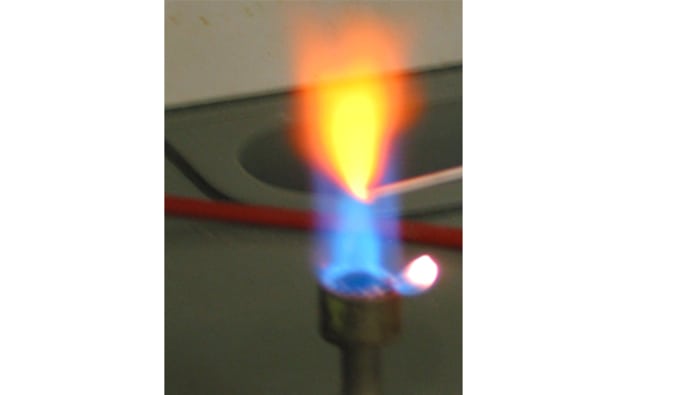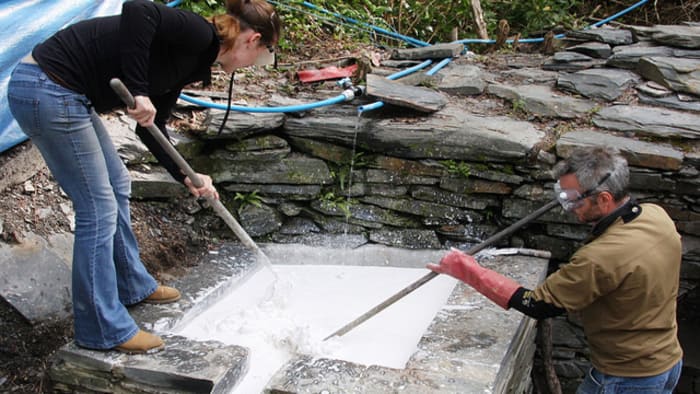Chemical and physical characteristics of calcium, its interaction with water
Why is it stored in a sealed container?

Calcium is found in the fourth large period, second group, main sub-group, with the atomic number 20. The atomic mass of calcium, according to the periodic table, is 40.08. The formula of the highest oxide is CaO. The symbol of the element is Ca, after the first two letters of the word calcium.
Characteristics of basic calcium
In ordinary conditions, calcium is a metal with a silvery-white color. With high chemical activity, the element can form many compounds that belong to different classes. The element has importance for technical and industrial chemical syntheses. It is widespread in the earth’s crust, with a percentage of around 1.5%. It is an alkaline earth element, as when it dissolves in water it forms alkalis, but in nature it is encountered in the form of numerous minerals and salts. Sea water has a high concentration of calcium (400 mg/l).
We have many chemical reactions sets for kids delivered under monthly subscription.

The characteristics of calcium depend on the arrangement of its crystal structure, which exist in two types – cubic face-centered and body-centered. The type of bond in the molecule of calcium is metallic.
Natural sources of calcium:
- apatites;
- alabaster;
- plaster;
- calcite;
- fluorite;
- dolomite.
Physical properties of calcium and methods for obtaining the metal
The aggregate state of calcium in ordinary conditions is solid, and the metal melts at a temperature of 842 degrees of Celsius. The element is a good conductor and heat conductor, and has a shiny silver-white color. When heated, it first moves to a liquid, then to a vaporous state, and loses its metallic properties. The density of the element is light – it is a soft metal that can be cut with a knife. It boils at a temperature of 1484 degrees Celsius.
When pressure is applied to calcium, it begins to lose its metallic properties and capacity for conducting electricity. But when pressure is increased further, the metallic properties are restored, and it displays the properties of a super-conductor, which exceeds other elements in these parameters by several times.
For a long time, it was not possible to obtain the metal in free form – owing to its high chemical activity, this element is not encountered in nature in pure form. The element was not discovered until the early 19th century. Calcium was first synthesized as a metal by the British scientist Humphrey Davy. He was the first to discover the nature of the interaction of compounds of solid metals and salts with an electric current. Nowadays, the electrolysis of calcium salts (mixtures of calcium and potassium chlorides, mixtures of calcium fluoride and chloride) is still the most effective method of obtaining the metal. Calcium is also extracted from its oxide with the use of aluminothermy – a method that is widespread in metallurgy.
The chemical properties of calcium
Calcium is an active metal that enters into many interactions. In normal conditions, it easily reacts with the formation of corresponding binary compounds: with oxygen and halogens. Click here for learning more about calcium compounds. When heated it reacts with nitrogen, hydrogen, carbon, silicon, boron, phosphorous, sulfur and other substances. In open air, it immediately interacts with oxygen and carbon dioxide, so it becomes covered with a grey coating. It reacts violently with acids, sometimes bursting into flame. Calcium displays interesting properties in the composition of salts. For example, cave stalactites and stalagmites consist of calcium carbonate which gradually forms from water, carbon dioxide and hydrocarbonate under the influence of processes inside underground water.
Owing to its high activity in an ordinary state, calcium is stored in the laboratory in a dark glass, with a tightly closed lid and under a layer of paraffin or kerosene. The qualitative reaction to the calcium ion is that a flame turns a bright, rich brick-red color.

The metal can be identified in the composition of compounds by the undissolved sediments of some salts of the element (fluoride, calcium carbonate, sulfate, silicate, phosphate, sulfite)
The reaction of water with calcium
Calcium is stored in container under a layer of protective liquid. To conduct an experiment to demonstrate how the reaction of water and calcium takes place, you cannot just take out the metal and cut off a piece of it. It is easier to use metallic calcium in the laboratory in the form of filings which are prepared with a lathe.
If you don’t have any filings, and there are no small pieces of calcium in the container, then you will need pliers or a hammer. Use the tool to separate the required piece of calcium, and place it in a flask or a glass of water. A calcium filing is placed in a dish in a gauze bag.
The calcium sinks to the bottom, and hydrogen is released – firstly in the place where the metal was broken off. Gradually, gas is released from the surface of the calcium – the process resembles vigorous boiling. At the same time a sediment of calcium hydroxide (slaked lime) is formed.

The piece of calcium rises to the surface, covered with hydrogen bubbles.
Within several tenths of a second the calcium dissolves, and from the suspension of hydroxide the water turns cloudy white. If you carry out the reaction in a test tube instead of a glass, you can observe the release of heat: the test tube quickly becomes hot. The reaction of calcium with water does not end with an effective explosion, but the two substances interact vigorously, making for an impressive sight. The experiment is safe.
If you take the bag with the remaining calcium out of the water and keep it in the air for a while, as a result of the continuing reaction it will heat up intensely, and the water remaining in the gauze will boil. If you filter part of the cloudy solution through a funnel into a glass, then if carbon dioxide is passed through the solution, a sediment will form. You do not need carbon dioxide gas for this, you can simply blow exhaled air into the solution through a glass straw.